Copyright Law and Artistic Expression
VerifiedAdded on 2020/05/04
|11
|3145
|249
AI Summary
This assignment examines the complexities surrounding copyright law and its implications for artistic creation. It delves into the tension between protecting creators' rights and fostering a culture of innovation and free expression. Key topics include analyzing fair use doctrine, understanding the legal boundaries of parody, and evaluating the impact of copyright law on education and political discourse. The assignment encourages critical thinking about the role of copyright in a democratic society.
Contribute Materials
Your contribution can guide someone’s learning journey. Share your
documents today.
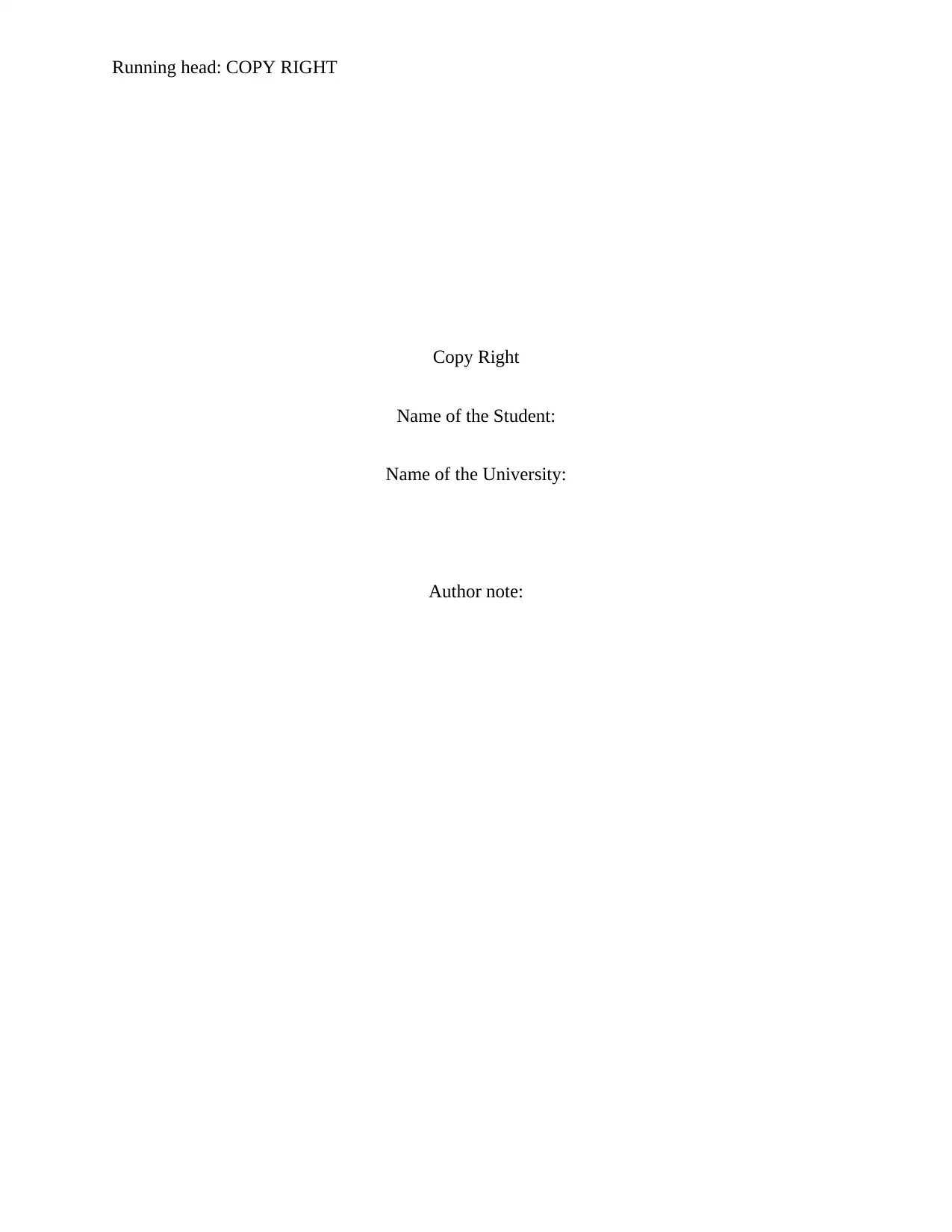
Running head: COPY RIGHT
Copy Right
Name of the Student:
Name of the University:
Author note:
Copy Right
Name of the Student:
Name of the University:
Author note:
Secure Best Marks with AI Grader
Need help grading? Try our AI Grader for instant feedback on your assignments.
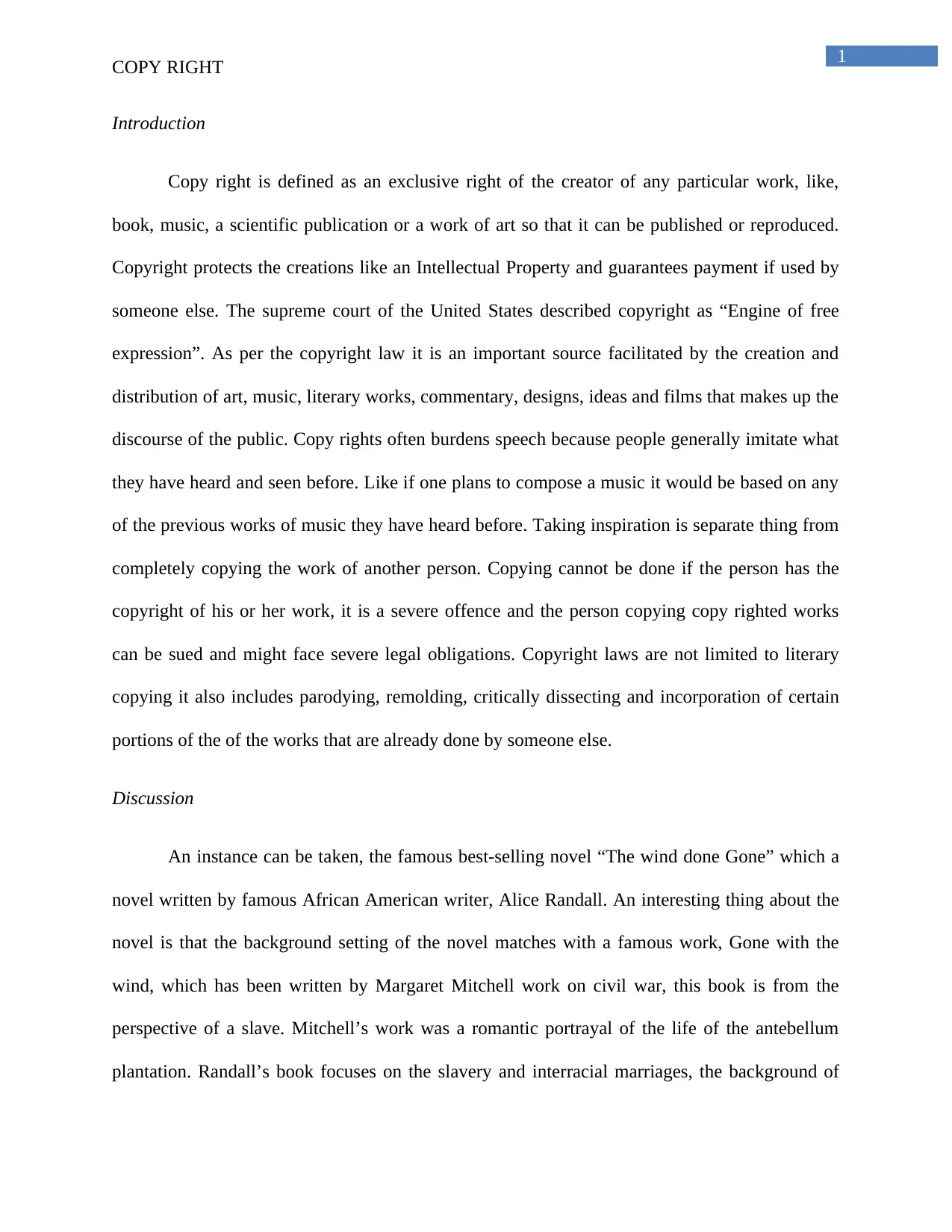
1
COPY RIGHT
Introduction
Copy right is defined as an exclusive right of the creator of any particular work, like,
book, music, a scientific publication or a work of art so that it can be published or reproduced.
Copyright protects the creations like an Intellectual Property and guarantees payment if used by
someone else. The supreme court of the United States described copyright as “Engine of free
expression”. As per the copyright law it is an important source facilitated by the creation and
distribution of art, music, literary works, commentary, designs, ideas and films that makes up the
discourse of the public. Copy rights often burdens speech because people generally imitate what
they have heard and seen before. Like if one plans to compose a music it would be based on any
of the previous works of music they have heard before. Taking inspiration is separate thing from
completely copying the work of another person. Copying cannot be done if the person has the
copyright of his or her work, it is a severe offence and the person copying copy righted works
can be sued and might face severe legal obligations. Copyright laws are not limited to literary
copying it also includes parodying, remolding, critically dissecting and incorporation of certain
portions of the of the works that are already done by someone else.
Discussion
An instance can be taken, the famous best-selling novel “The wind done Gone” which a
novel written by famous African American writer, Alice Randall. An interesting thing about the
novel is that the background setting of the novel matches with a famous work, Gone with the
wind, which has been written by Margaret Mitchell work on civil war, this book is from the
perspective of a slave. Mitchell’s work was a romantic portrayal of the life of the antebellum
plantation. Randall’s book focuses on the slavery and interracial marriages, the background of
COPY RIGHT
Introduction
Copy right is defined as an exclusive right of the creator of any particular work, like,
book, music, a scientific publication or a work of art so that it can be published or reproduced.
Copyright protects the creations like an Intellectual Property and guarantees payment if used by
someone else. The supreme court of the United States described copyright as “Engine of free
expression”. As per the copyright law it is an important source facilitated by the creation and
distribution of art, music, literary works, commentary, designs, ideas and films that makes up the
discourse of the public. Copy rights often burdens speech because people generally imitate what
they have heard and seen before. Like if one plans to compose a music it would be based on any
of the previous works of music they have heard before. Taking inspiration is separate thing from
completely copying the work of another person. Copying cannot be done if the person has the
copyright of his or her work, it is a severe offence and the person copying copy righted works
can be sued and might face severe legal obligations. Copyright laws are not limited to literary
copying it also includes parodying, remolding, critically dissecting and incorporation of certain
portions of the of the works that are already done by someone else.
Discussion
An instance can be taken, the famous best-selling novel “The wind done Gone” which a
novel written by famous African American writer, Alice Randall. An interesting thing about the
novel is that the background setting of the novel matches with a famous work, Gone with the
wind, which has been written by Margaret Mitchell work on civil war, this book is from the
perspective of a slave. Mitchell’s work was a romantic portrayal of the life of the antebellum
plantation. Randall’s book focuses on the slavery and interracial marriages, the background of
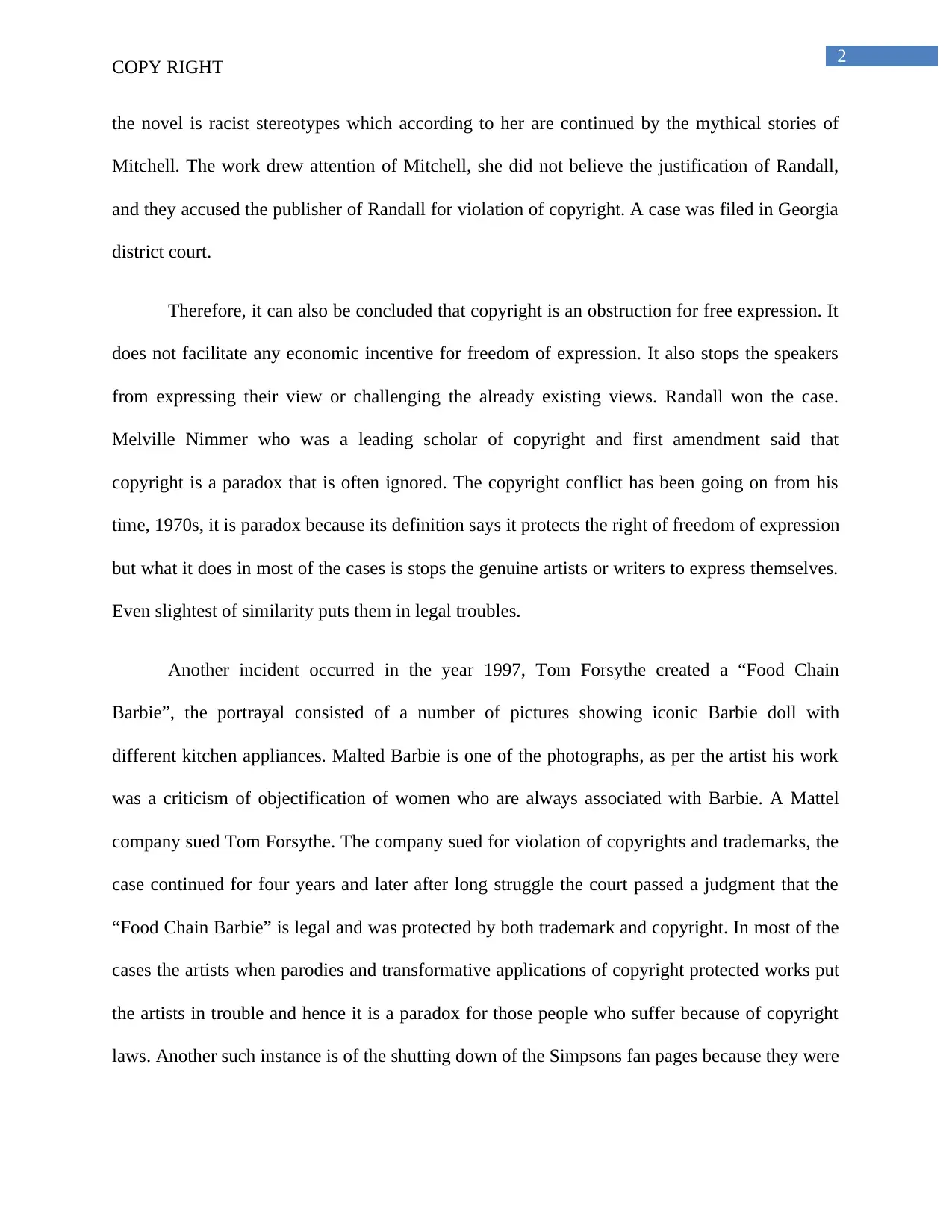
2
COPY RIGHT
the novel is racist stereotypes which according to her are continued by the mythical stories of
Mitchell. The work drew attention of Mitchell, she did not believe the justification of Randall,
and they accused the publisher of Randall for violation of copyright. A case was filed in Georgia
district court.
Therefore, it can also be concluded that copyright is an obstruction for free expression. It
does not facilitate any economic incentive for freedom of expression. It also stops the speakers
from expressing their view or challenging the already existing views. Randall won the case.
Melville Nimmer who was a leading scholar of copyright and first amendment said that
copyright is a paradox that is often ignored. The copyright conflict has been going on from his
time, 1970s, it is paradox because its definition says it protects the right of freedom of expression
but what it does in most of the cases is stops the genuine artists or writers to express themselves.
Even slightest of similarity puts them in legal troubles.
Another incident occurred in the year 1997, Tom Forsythe created a “Food Chain
Barbie”, the portrayal consisted of a number of pictures showing iconic Barbie doll with
different kitchen appliances. Malted Barbie is one of the photographs, as per the artist his work
was a criticism of objectification of women who are always associated with Barbie. A Mattel
company sued Tom Forsythe. The company sued for violation of copyrights and trademarks, the
case continued for four years and later after long struggle the court passed a judgment that the
“Food Chain Barbie” is legal and was protected by both trademark and copyright. In most of the
cases the artists when parodies and transformative applications of copyright protected works put
the artists in trouble and hence it is a paradox for those people who suffer because of copyright
laws. Another such instance is of the shutting down of the Simpsons fan pages because they were
COPY RIGHT
the novel is racist stereotypes which according to her are continued by the mythical stories of
Mitchell. The work drew attention of Mitchell, she did not believe the justification of Randall,
and they accused the publisher of Randall for violation of copyright. A case was filed in Georgia
district court.
Therefore, it can also be concluded that copyright is an obstruction for free expression. It
does not facilitate any economic incentive for freedom of expression. It also stops the speakers
from expressing their view or challenging the already existing views. Randall won the case.
Melville Nimmer who was a leading scholar of copyright and first amendment said that
copyright is a paradox that is often ignored. The copyright conflict has been going on from his
time, 1970s, it is paradox because its definition says it protects the right of freedom of expression
but what it does in most of the cases is stops the genuine artists or writers to express themselves.
Even slightest of similarity puts them in legal troubles.
Another incident occurred in the year 1997, Tom Forsythe created a “Food Chain
Barbie”, the portrayal consisted of a number of pictures showing iconic Barbie doll with
different kitchen appliances. Malted Barbie is one of the photographs, as per the artist his work
was a criticism of objectification of women who are always associated with Barbie. A Mattel
company sued Tom Forsythe. The company sued for violation of copyrights and trademarks, the
case continued for four years and later after long struggle the court passed a judgment that the
“Food Chain Barbie” is legal and was protected by both trademark and copyright. In most of the
cases the artists when parodies and transformative applications of copyright protected works put
the artists in trouble and hence it is a paradox for those people who suffer because of copyright
laws. Another such instance is of the shutting down of the Simpsons fan pages because they were
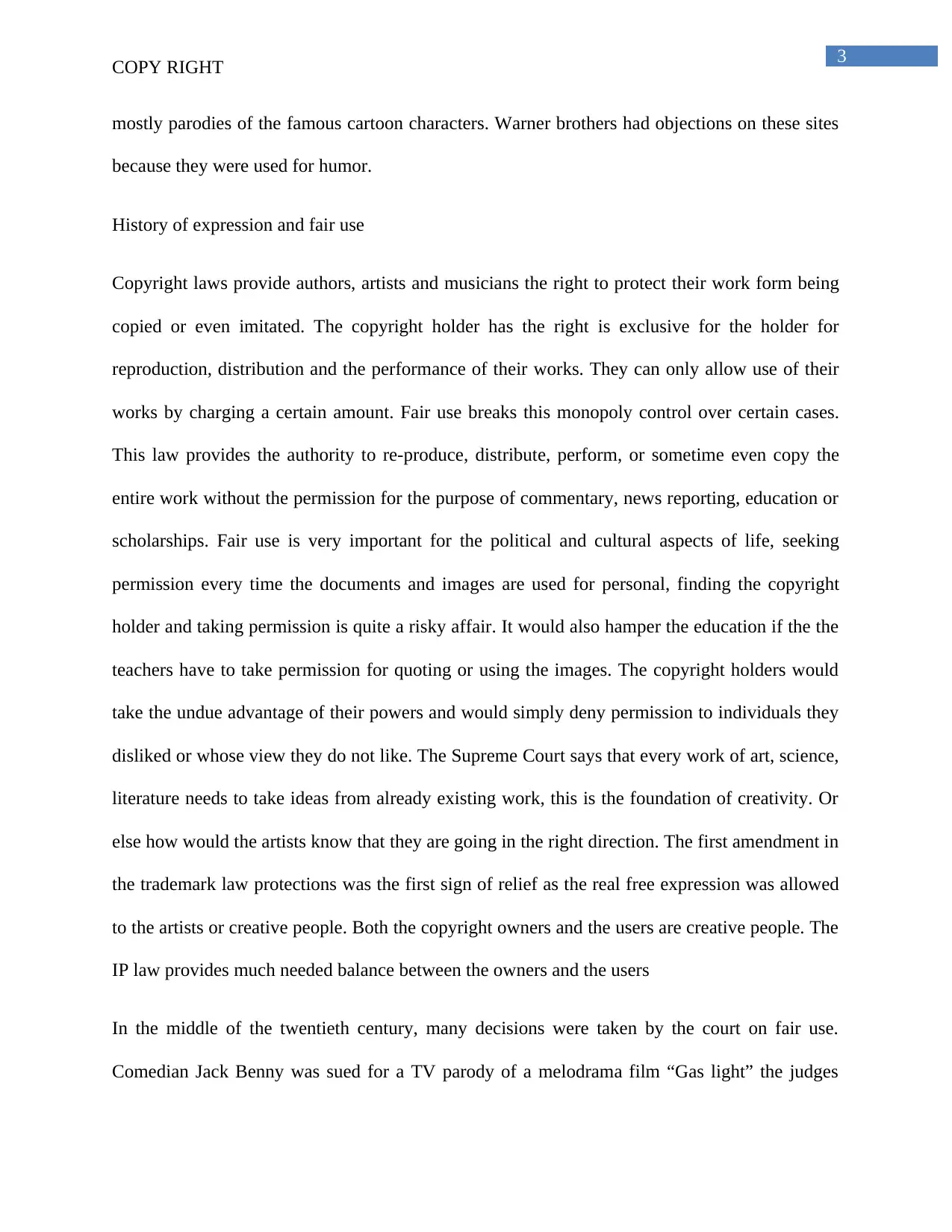
3
COPY RIGHT
mostly parodies of the famous cartoon characters. Warner brothers had objections on these sites
because they were used for humor.
History of expression and fair use
Copyright laws provide authors, artists and musicians the right to protect their work form being
copied or even imitated. The copyright holder has the right is exclusive for the holder for
reproduction, distribution and the performance of their works. They can only allow use of their
works by charging a certain amount. Fair use breaks this monopoly control over certain cases.
This law provides the authority to re-produce, distribute, perform, or sometime even copy the
entire work without the permission for the purpose of commentary, news reporting, education or
scholarships. Fair use is very important for the political and cultural aspects of life, seeking
permission every time the documents and images are used for personal, finding the copyright
holder and taking permission is quite a risky affair. It would also hamper the education if the the
teachers have to take permission for quoting or using the images. The copyright holders would
take the undue advantage of their powers and would simply deny permission to individuals they
disliked or whose view they do not like. The Supreme Court says that every work of art, science,
literature needs to take ideas from already existing work, this is the foundation of creativity. Or
else how would the artists know that they are going in the right direction. The first amendment in
the trademark law protections was the first sign of relief as the real free expression was allowed
to the artists or creative people. Both the copyright owners and the users are creative people. The
IP law provides much needed balance between the owners and the users
In the middle of the twentieth century, many decisions were taken by the court on fair use.
Comedian Jack Benny was sued for a TV parody of a melodrama film “Gas light” the judges
COPY RIGHT
mostly parodies of the famous cartoon characters. Warner brothers had objections on these sites
because they were used for humor.
History of expression and fair use
Copyright laws provide authors, artists and musicians the right to protect their work form being
copied or even imitated. The copyright holder has the right is exclusive for the holder for
reproduction, distribution and the performance of their works. They can only allow use of their
works by charging a certain amount. Fair use breaks this monopoly control over certain cases.
This law provides the authority to re-produce, distribute, perform, or sometime even copy the
entire work without the permission for the purpose of commentary, news reporting, education or
scholarships. Fair use is very important for the political and cultural aspects of life, seeking
permission every time the documents and images are used for personal, finding the copyright
holder and taking permission is quite a risky affair. It would also hamper the education if the the
teachers have to take permission for quoting or using the images. The copyright holders would
take the undue advantage of their powers and would simply deny permission to individuals they
disliked or whose view they do not like. The Supreme Court says that every work of art, science,
literature needs to take ideas from already existing work, this is the foundation of creativity. Or
else how would the artists know that they are going in the right direction. The first amendment in
the trademark law protections was the first sign of relief as the real free expression was allowed
to the artists or creative people. Both the copyright owners and the users are creative people. The
IP law provides much needed balance between the owners and the users
In the middle of the twentieth century, many decisions were taken by the court on fair use.
Comedian Jack Benny was sued for a TV parody of a melodrama film “Gas light” the judges
Secure Best Marks with AI Grader
Need help grading? Try our AI Grader for instant feedback on your assignments.
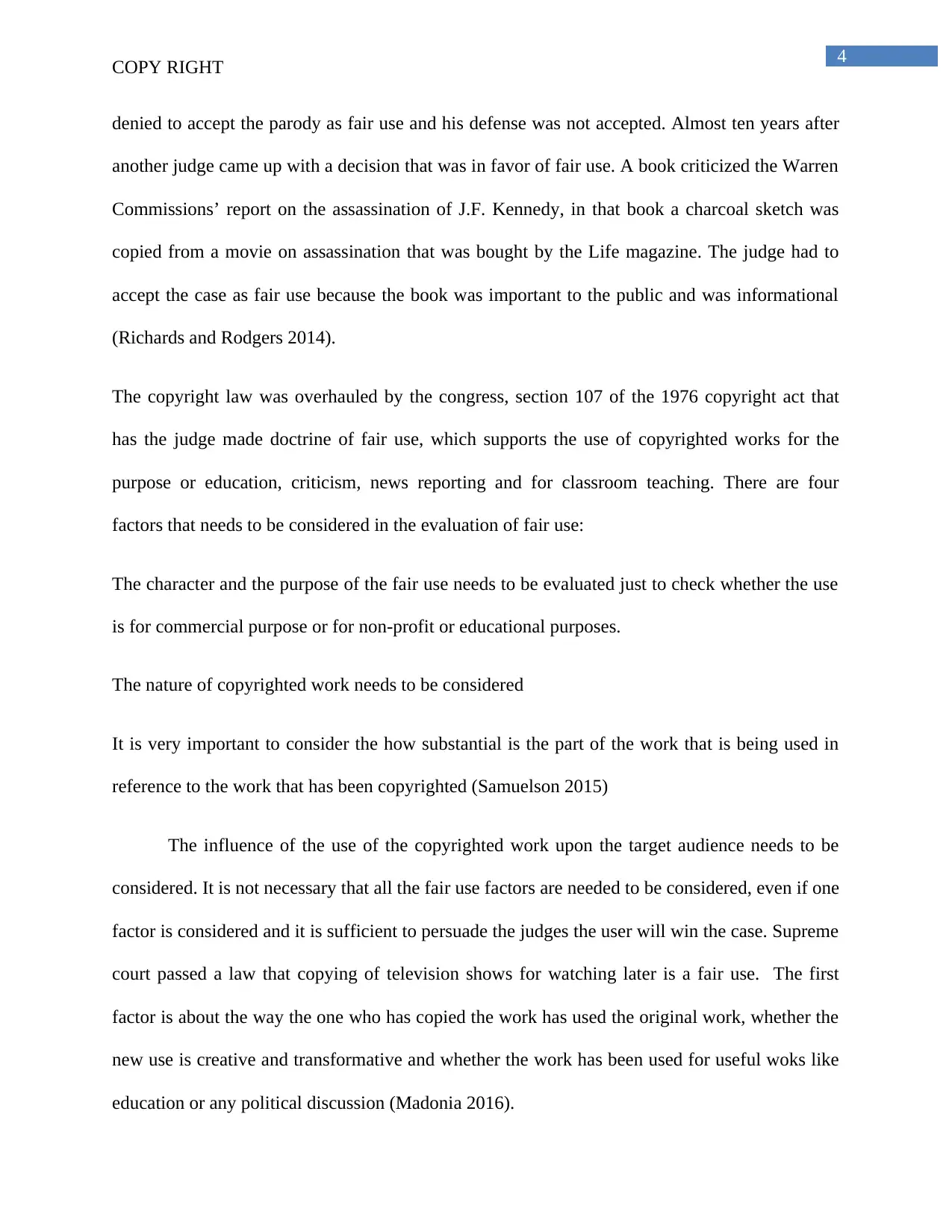
4
COPY RIGHT
denied to accept the parody as fair use and his defense was not accepted. Almost ten years after
another judge came up with a decision that was in favor of fair use. A book criticized the Warren
Commissions’ report on the assassination of J.F. Kennedy, in that book a charcoal sketch was
copied from a movie on assassination that was bought by the Life magazine. The judge had to
accept the case as fair use because the book was important to the public and was informational
(Richards and Rodgers 2014).
The copyright law was overhauled by the congress, section 107 of the 1976 copyright act that
has the judge made doctrine of fair use, which supports the use of copyrighted works for the
purpose or education, criticism, news reporting and for classroom teaching. There are four
factors that needs to be considered in the evaluation of fair use:
The character and the purpose of the fair use needs to be evaluated just to check whether the use
is for commercial purpose or for non-profit or educational purposes.
The nature of copyrighted work needs to be considered
It is very important to consider the how substantial is the part of the work that is being used in
reference to the work that has been copyrighted (Samuelson 2015)
The influence of the use of the copyrighted work upon the target audience needs to be
considered. It is not necessary that all the fair use factors are needed to be considered, even if one
factor is considered and it is sufficient to persuade the judges the user will win the case. Supreme
court passed a law that copying of television shows for watching later is a fair use. The first
factor is about the way the one who has copied the work has used the original work, whether the
new use is creative and transformative and whether the work has been used for useful woks like
education or any political discussion (Madonia 2016).
COPY RIGHT
denied to accept the parody as fair use and his defense was not accepted. Almost ten years after
another judge came up with a decision that was in favor of fair use. A book criticized the Warren
Commissions’ report on the assassination of J.F. Kennedy, in that book a charcoal sketch was
copied from a movie on assassination that was bought by the Life magazine. The judge had to
accept the case as fair use because the book was important to the public and was informational
(Richards and Rodgers 2014).
The copyright law was overhauled by the congress, section 107 of the 1976 copyright act that
has the judge made doctrine of fair use, which supports the use of copyrighted works for the
purpose or education, criticism, news reporting and for classroom teaching. There are four
factors that needs to be considered in the evaluation of fair use:
The character and the purpose of the fair use needs to be evaluated just to check whether the use
is for commercial purpose or for non-profit or educational purposes.
The nature of copyrighted work needs to be considered
It is very important to consider the how substantial is the part of the work that is being used in
reference to the work that has been copyrighted (Samuelson 2015)
The influence of the use of the copyrighted work upon the target audience needs to be
considered. It is not necessary that all the fair use factors are needed to be considered, even if one
factor is considered and it is sufficient to persuade the judges the user will win the case. Supreme
court passed a law that copying of television shows for watching later is a fair use. The first
factor is about the way the one who has copied the work has used the original work, whether the
new use is creative and transformative and whether the work has been used for useful woks like
education or any political discussion (Madonia 2016).
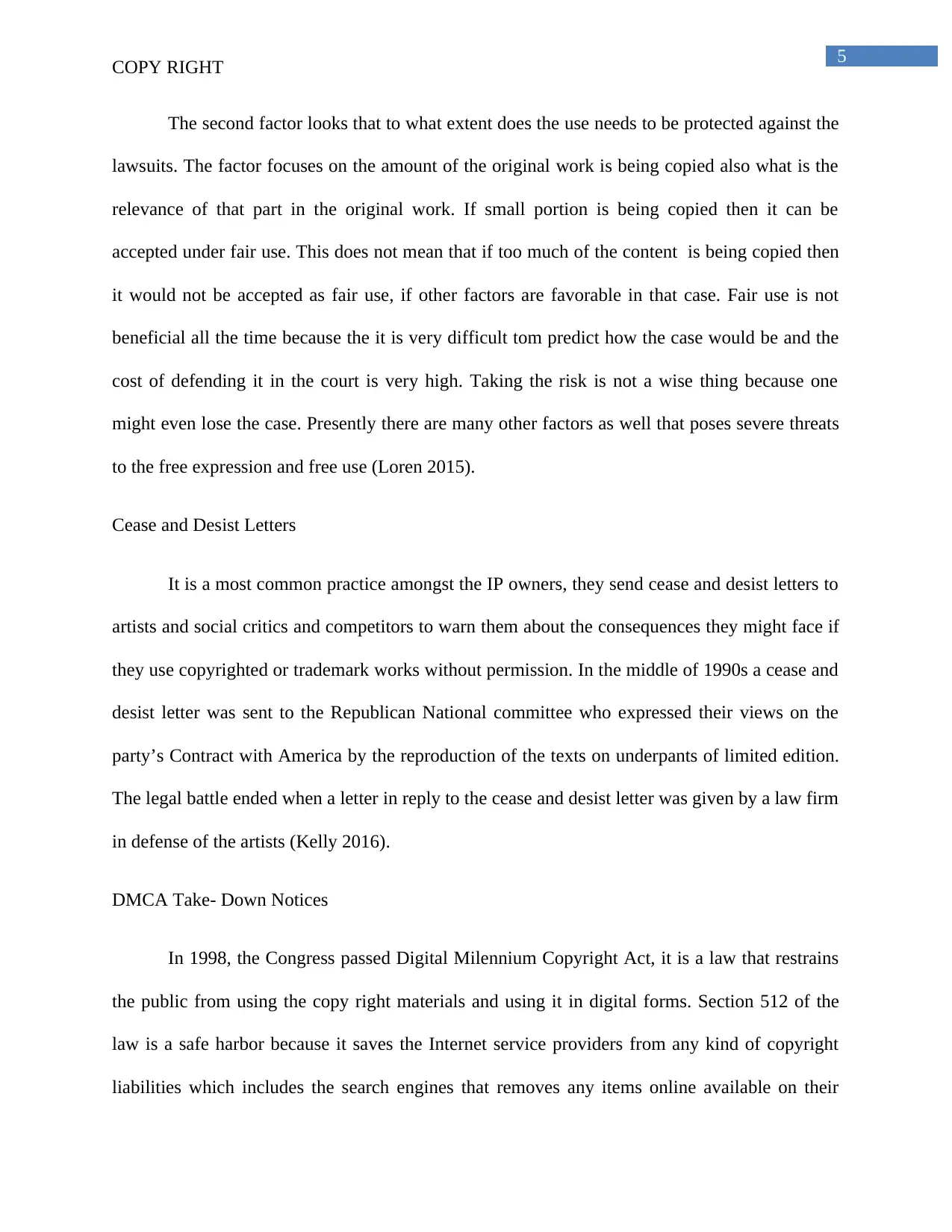
5
COPY RIGHT
The second factor looks that to what extent does the use needs to be protected against the
lawsuits. The factor focuses on the amount of the original work is being copied also what is the
relevance of that part in the original work. If small portion is being copied then it can be
accepted under fair use. This does not mean that if too much of the content is being copied then
it would not be accepted as fair use, if other factors are favorable in that case. Fair use is not
beneficial all the time because the it is very difficult tom predict how the case would be and the
cost of defending it in the court is very high. Taking the risk is not a wise thing because one
might even lose the case. Presently there are many other factors as well that poses severe threats
to the free expression and free use (Loren 2015).
Cease and Desist Letters
It is a most common practice amongst the IP owners, they send cease and desist letters to
artists and social critics and competitors to warn them about the consequences they might face if
they use copyrighted or trademark works without permission. In the middle of 1990s a cease and
desist letter was sent to the Republican National committee who expressed their views on the
party’s Contract with America by the reproduction of the texts on underpants of limited edition.
The legal battle ended when a letter in reply to the cease and desist letter was given by a law firm
in defense of the artists (Kelly 2016).
DMCA Take- Down Notices
In 1998, the Congress passed Digital Milennium Copyright Act, it is a law that restrains
the public from using the copy right materials and using it in digital forms. Section 512 of the
law is a safe harbor because it saves the Internet service providers from any kind of copyright
liabilities which includes the search engines that removes any items online available on their
COPY RIGHT
The second factor looks that to what extent does the use needs to be protected against the
lawsuits. The factor focuses on the amount of the original work is being copied also what is the
relevance of that part in the original work. If small portion is being copied then it can be
accepted under fair use. This does not mean that if too much of the content is being copied then
it would not be accepted as fair use, if other factors are favorable in that case. Fair use is not
beneficial all the time because the it is very difficult tom predict how the case would be and the
cost of defending it in the court is very high. Taking the risk is not a wise thing because one
might even lose the case. Presently there are many other factors as well that poses severe threats
to the free expression and free use (Loren 2015).
Cease and Desist Letters
It is a most common practice amongst the IP owners, they send cease and desist letters to
artists and social critics and competitors to warn them about the consequences they might face if
they use copyrighted or trademark works without permission. In the middle of 1990s a cease and
desist letter was sent to the Republican National committee who expressed their views on the
party’s Contract with America by the reproduction of the texts on underpants of limited edition.
The legal battle ended when a letter in reply to the cease and desist letter was given by a law firm
in defense of the artists (Kelly 2016).
DMCA Take- Down Notices
In 1998, the Congress passed Digital Milennium Copyright Act, it is a law that restrains
the public from using the copy right materials and using it in digital forms. Section 512 of the
law is a safe harbor because it saves the Internet service providers from any kind of copyright
liabilities which includes the search engines that removes any items online available on their

6
COPY RIGHT
servers which is called as infringement by the owners of the copyright. This requires no legal
proceedings. The ISP subscriber is not allowed to send any notice in reply to the owner of
copyright, as per this particular section of the law. This particular section of the is not justified
because the Internet service providers are not liable for any kind of copyright infringement. Like
cease and desist letters the section 512 take down notices few elements are not eligible for being
called as fair use and the copyright holders can reject the take down letters without even going to
the court (Robertson and Butler 2014).
The case of of Diebold Inc can be taken as the right example, a manufacturing company
of voting machines had sent a takedown letter to the Swarthmore university and few Internet
service providers, the company wanted the students to remove the posts that had emails of the
employees of Diebold, in which the defects of the machines where discussed. In reaction to this
the students filed a case against the company and the court passed a judgment in favor of the
students that it was fair use, eventually Diebold had to back-off (Joyce et al. 2016).
Music is one of the areas where one might think that their composition is fair use still
they might be sued. In most of the cases it becomes difficult to find the copyright writer which
makes the filmmaker to abandon the music they have selected. This results in a lot of footage of
the films being removed because of non-availability of permissions or it is too expensive for
copying. At the time when Wright brothers first showed their invention of the Airplanes, there
was a law that the the property owner of the land is not just the owner of the surface but also the
owner of the land below his land and the space above his land, to indefinite extent. This was not
at all a problem then because airplanes were not started completely, later when it started it
became an issue of conflict, that whether the passing of planes above one’s land is trespassing or
not. This compelled the necessary changes. Copyright infringement has always been an issue of
COPY RIGHT
servers which is called as infringement by the owners of the copyright. This requires no legal
proceedings. The ISP subscriber is not allowed to send any notice in reply to the owner of
copyright, as per this particular section of the law. This particular section of the is not justified
because the Internet service providers are not liable for any kind of copyright infringement. Like
cease and desist letters the section 512 take down notices few elements are not eligible for being
called as fair use and the copyright holders can reject the take down letters without even going to
the court (Robertson and Butler 2014).
The case of of Diebold Inc can be taken as the right example, a manufacturing company
of voting machines had sent a takedown letter to the Swarthmore university and few Internet
service providers, the company wanted the students to remove the posts that had emails of the
employees of Diebold, in which the defects of the machines where discussed. In reaction to this
the students filed a case against the company and the court passed a judgment in favor of the
students that it was fair use, eventually Diebold had to back-off (Joyce et al. 2016).
Music is one of the areas where one might think that their composition is fair use still
they might be sued. In most of the cases it becomes difficult to find the copyright writer which
makes the filmmaker to abandon the music they have selected. This results in a lot of footage of
the films being removed because of non-availability of permissions or it is too expensive for
copying. At the time when Wright brothers first showed their invention of the Airplanes, there
was a law that the the property owner of the land is not just the owner of the surface but also the
owner of the land below his land and the space above his land, to indefinite extent. This was not
at all a problem then because airplanes were not started completely, later when it started it
became an issue of conflict, that whether the passing of planes above one’s land is trespassing or
not. This compelled the necessary changes. Copyright infringement has always been an issue of
Paraphrase This Document
Need a fresh take? Get an instant paraphrase of this document with our AI Paraphraser
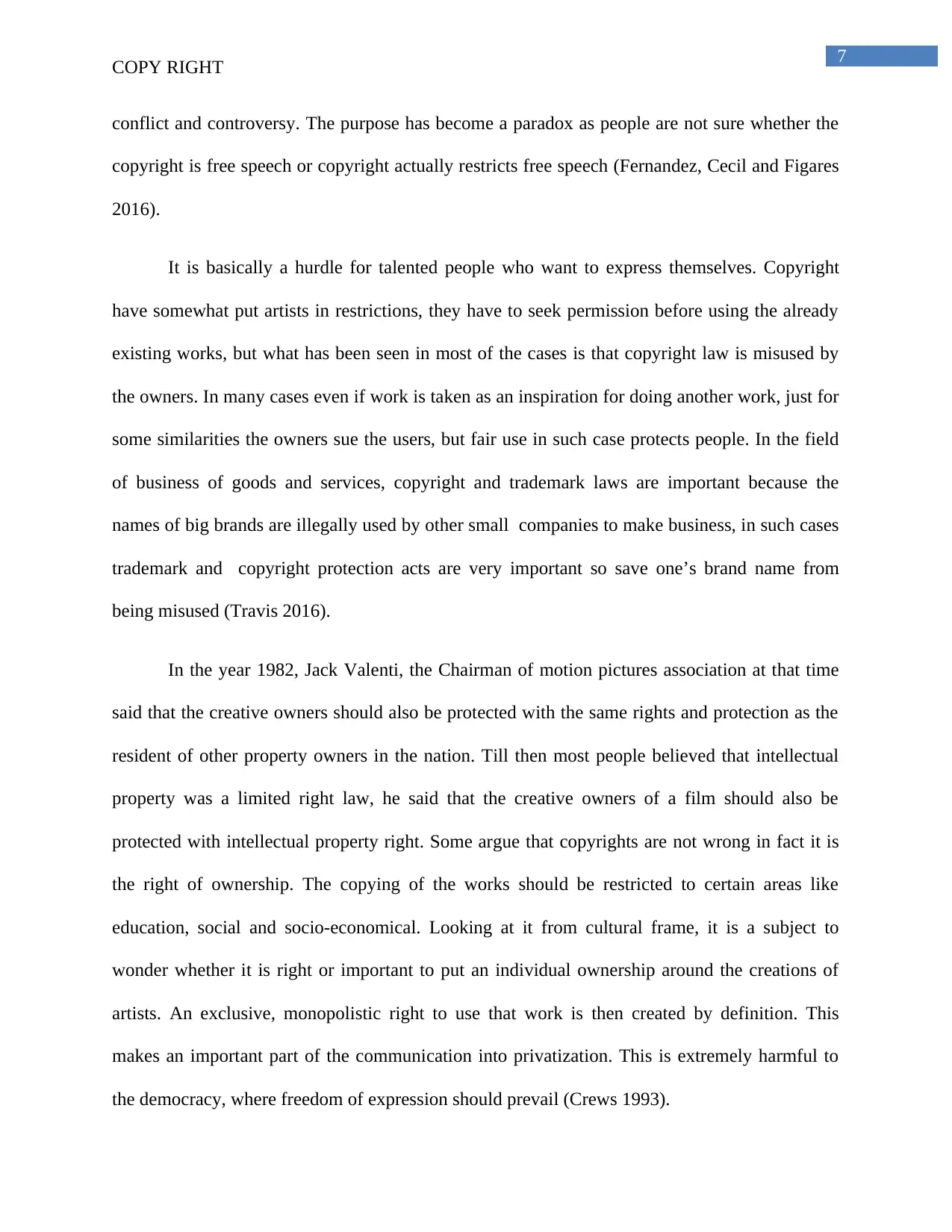
7
COPY RIGHT
conflict and controversy. The purpose has become a paradox as people are not sure whether the
copyright is free speech or copyright actually restricts free speech (Fernandez, Cecil and Figares
2016).
It is basically a hurdle for talented people who want to express themselves. Copyright
have somewhat put artists in restrictions, they have to seek permission before using the already
existing works, but what has been seen in most of the cases is that copyright law is misused by
the owners. In many cases even if work is taken as an inspiration for doing another work, just for
some similarities the owners sue the users, but fair use in such case protects people. In the field
of business of goods and services, copyright and trademark laws are important because the
names of big brands are illegally used by other small companies to make business, in such cases
trademark and copyright protection acts are very important so save one’s brand name from
being misused (Travis 2016).
In the year 1982, Jack Valenti, the Chairman of motion pictures association at that time
said that the creative owners should also be protected with the same rights and protection as the
resident of other property owners in the nation. Till then most people believed that intellectual
property was a limited right law, he said that the creative owners of a film should also be
protected with intellectual property right. Some argue that copyrights are not wrong in fact it is
the right of ownership. The copying of the works should be restricted to certain areas like
education, social and socio-economical. Looking at it from cultural frame, it is a subject to
wonder whether it is right or important to put an individual ownership around the creations of
artists. An exclusive, monopolistic right to use that work is then created by definition. This
makes an important part of the communication into privatization. This is extremely harmful to
the democracy, where freedom of expression should prevail (Crews 1993).
COPY RIGHT
conflict and controversy. The purpose has become a paradox as people are not sure whether the
copyright is free speech or copyright actually restricts free speech (Fernandez, Cecil and Figares
2016).
It is basically a hurdle for talented people who want to express themselves. Copyright
have somewhat put artists in restrictions, they have to seek permission before using the already
existing works, but what has been seen in most of the cases is that copyright law is misused by
the owners. In many cases even if work is taken as an inspiration for doing another work, just for
some similarities the owners sue the users, but fair use in such case protects people. In the field
of business of goods and services, copyright and trademark laws are important because the
names of big brands are illegally used by other small companies to make business, in such cases
trademark and copyright protection acts are very important so save one’s brand name from
being misused (Travis 2016).
In the year 1982, Jack Valenti, the Chairman of motion pictures association at that time
said that the creative owners should also be protected with the same rights and protection as the
resident of other property owners in the nation. Till then most people believed that intellectual
property was a limited right law, he said that the creative owners of a film should also be
protected with intellectual property right. Some argue that copyrights are not wrong in fact it is
the right of ownership. The copying of the works should be restricted to certain areas like
education, social and socio-economical. Looking at it from cultural frame, it is a subject to
wonder whether it is right or important to put an individual ownership around the creations of
artists. An exclusive, monopolistic right to use that work is then created by definition. This
makes an important part of the communication into privatization. This is extremely harmful to
the democracy, where freedom of expression should prevail (Crews 1993).

8
COPY RIGHT
Conclusion
The purpose of copyright protects the right of the owners while the rights of some artists
are completely ignored. It is very difficult to determine whether the work has been copied or it is
a creation of any artist. It may happen that an artist uses particular case as a reference, so putting
an infringement case on that artist would not be the right thing to do because it is right of all to
express their views either through art or writings or through music on any particular topic. As far
as parodies are concerned, then it needs to be taken as amusement because parodies are intended
to do that. It is also creativity to modify already existing work in one’s own way. The law related
to copyright needs a lot of modification also the copyright owners needs to consider that at times
the copyright laws suppresses the rights of other creators or artists. It creates a monopolistic
situation and restricts competition. On the contrary it can also be said that the right is also
required because there are certain cases where the cases of copying designs, works or literary
works have been found, in such cases it is required that owners protect their works. They also
have the right to ownership but in case of education and political purposes copyright is irrelevant
because it restricts flow of information.
COPY RIGHT
Conclusion
The purpose of copyright protects the right of the owners while the rights of some artists
are completely ignored. It is very difficult to determine whether the work has been copied or it is
a creation of any artist. It may happen that an artist uses particular case as a reference, so putting
an infringement case on that artist would not be the right thing to do because it is right of all to
express their views either through art or writings or through music on any particular topic. As far
as parodies are concerned, then it needs to be taken as amusement because parodies are intended
to do that. It is also creativity to modify already existing work in one’s own way. The law related
to copyright needs a lot of modification also the copyright owners needs to consider that at times
the copyright laws suppresses the rights of other creators or artists. It creates a monopolistic
situation and restricts competition. On the contrary it can also be said that the right is also
required because there are certain cases where the cases of copying designs, works or literary
works have been found, in such cases it is required that owners protect their works. They also
have the right to ownership but in case of education and political purposes copyright is irrelevant
because it restricts flow of information.
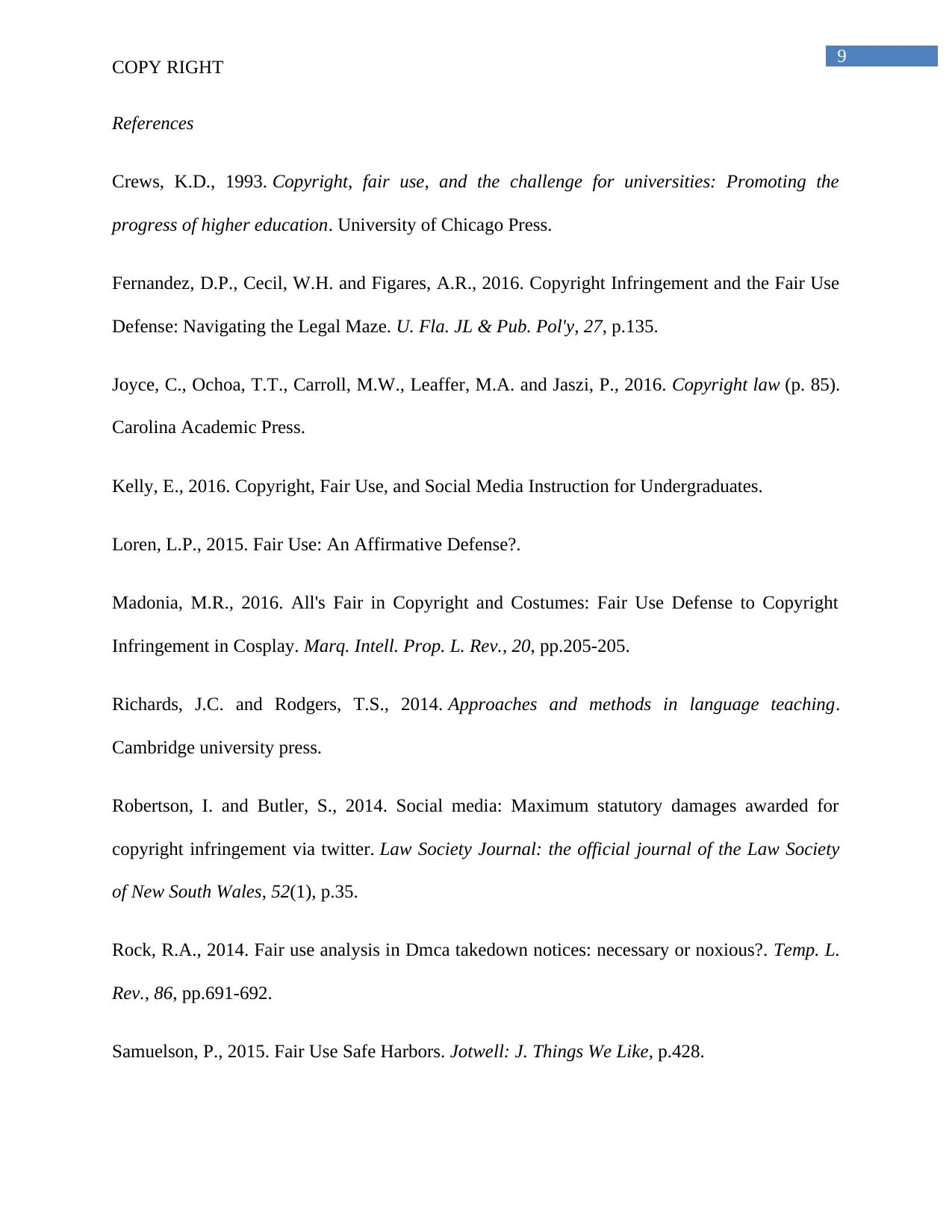
9
COPY RIGHT
References
Crews, K.D., 1993. Copyright, fair use, and the challenge for universities: Promoting the
progress of higher education. University of Chicago Press.
Fernandez, D.P., Cecil, W.H. and Figares, A.R., 2016. Copyright Infringement and the Fair Use
Defense: Navigating the Legal Maze. U. Fla. JL & Pub. Pol'y, 27, p.135.
Joyce, C., Ochoa, T.T., Carroll, M.W., Leaffer, M.A. and Jaszi, P., 2016. Copyright law (p. 85).
Carolina Academic Press.
Kelly, E., 2016. Copyright, Fair Use, and Social Media Instruction for Undergraduates.
Loren, L.P., 2015. Fair Use: An Affirmative Defense?.
Madonia, M.R., 2016. All's Fair in Copyright and Costumes: Fair Use Defense to Copyright
Infringement in Cosplay. Marq. Intell. Prop. L. Rev., 20, pp.205-205.
Richards, J.C. and Rodgers, T.S., 2014. Approaches and methods in language teaching.
Cambridge university press.
Robertson, I. and Butler, S., 2014. Social media: Maximum statutory damages awarded for
copyright infringement via twitter. Law Society Journal: the official journal of the Law Society
of New South Wales, 52(1), p.35.
Rock, R.A., 2014. Fair use analysis in Dmca takedown notices: necessary or noxious?. Temp. L.
Rev., 86, pp.691-692.
Samuelson, P., 2015. Fair Use Safe Harbors. Jotwell: J. Things We Like, p.428.
COPY RIGHT
References
Crews, K.D., 1993. Copyright, fair use, and the challenge for universities: Promoting the
progress of higher education. University of Chicago Press.
Fernandez, D.P., Cecil, W.H. and Figares, A.R., 2016. Copyright Infringement and the Fair Use
Defense: Navigating the Legal Maze. U. Fla. JL & Pub. Pol'y, 27, p.135.
Joyce, C., Ochoa, T.T., Carroll, M.W., Leaffer, M.A. and Jaszi, P., 2016. Copyright law (p. 85).
Carolina Academic Press.
Kelly, E., 2016. Copyright, Fair Use, and Social Media Instruction for Undergraduates.
Loren, L.P., 2015. Fair Use: An Affirmative Defense?.
Madonia, M.R., 2016. All's Fair in Copyright and Costumes: Fair Use Defense to Copyright
Infringement in Cosplay. Marq. Intell. Prop. L. Rev., 20, pp.205-205.
Richards, J.C. and Rodgers, T.S., 2014. Approaches and methods in language teaching.
Cambridge university press.
Robertson, I. and Butler, S., 2014. Social media: Maximum statutory damages awarded for
copyright infringement via twitter. Law Society Journal: the official journal of the Law Society
of New South Wales, 52(1), p.35.
Rock, R.A., 2014. Fair use analysis in Dmca takedown notices: necessary or noxious?. Temp. L.
Rev., 86, pp.691-692.
Samuelson, P., 2015. Fair Use Safe Harbors. Jotwell: J. Things We Like, p.428.
Secure Best Marks with AI Grader
Need help grading? Try our AI Grader for instant feedback on your assignments.
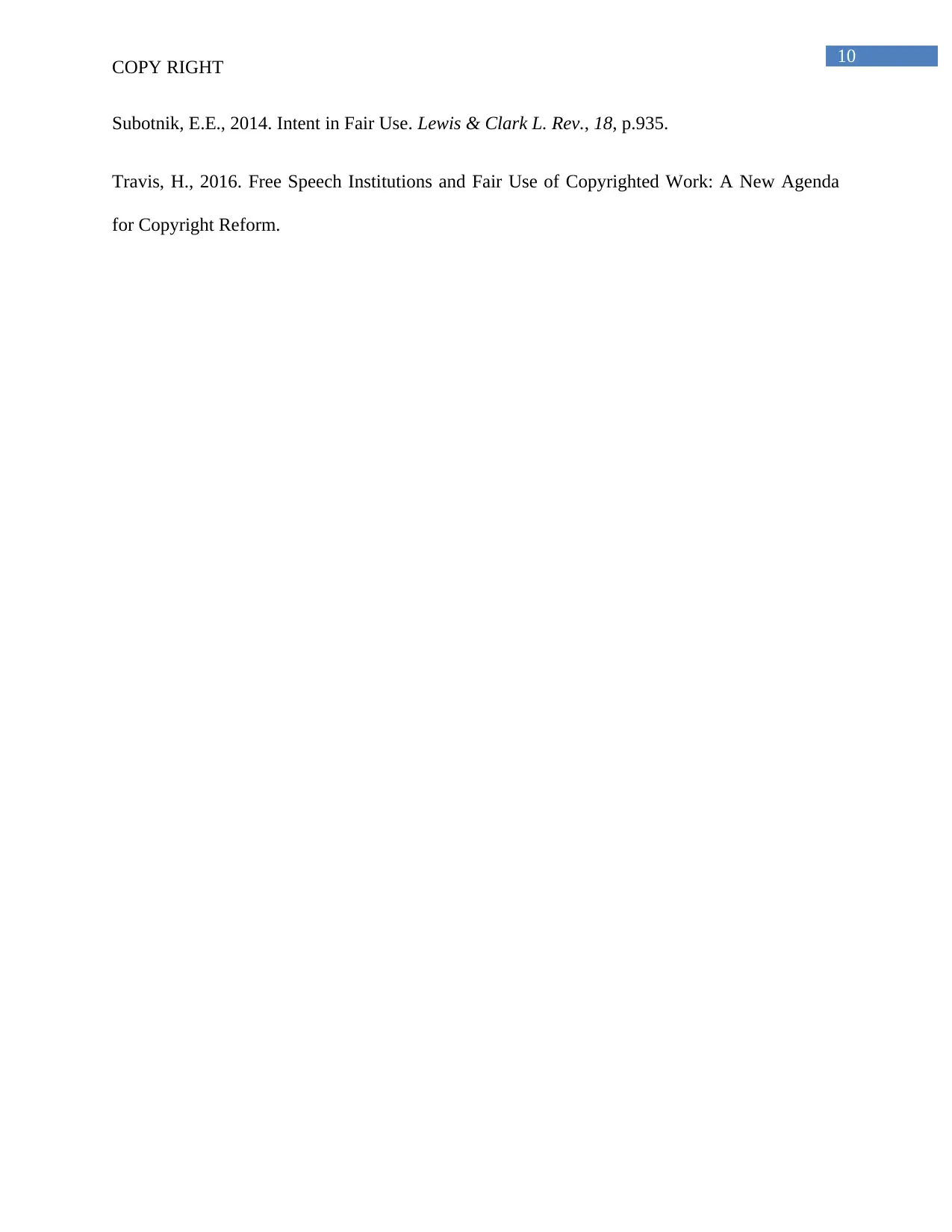
10
COPY RIGHT
Subotnik, E.E., 2014. Intent in Fair Use. Lewis & Clark L. Rev., 18, p.935.
Travis, H., 2016. Free Speech Institutions and Fair Use of Copyrighted Work: A New Agenda
for Copyright Reform.
COPY RIGHT
Subotnik, E.E., 2014. Intent in Fair Use. Lewis & Clark L. Rev., 18, p.935.
Travis, H., 2016. Free Speech Institutions and Fair Use of Copyrighted Work: A New Agenda
for Copyright Reform.
1 out of 11
Related Documents
Your All-in-One AI-Powered Toolkit for Academic Success.
+13062052269
info@desklib.com
Available 24*7 on WhatsApp / Email
![[object Object]](/_next/static/media/star-bottom.7253800d.svg)
Unlock your academic potential
© 2024 | Zucol Services PVT LTD | All rights reserved.
